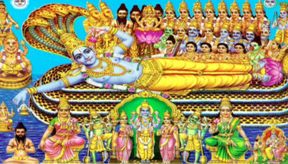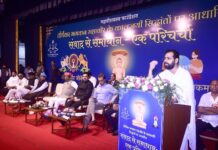 The concept of Adhika Maas is unique to the traditional Hindu lunar calendar based on the cycles of the Moon. The lunar calendar adds one extra month every third year. This extra month is known as Adhik Maas, Mal Maas, Purushottam Maas, Malimmacha, Adhik Ashad Maas or Adhik Ashada Mahina.
The concept of Adhika Maas is unique to the traditional Hindu lunar calendar based on the cycles of the Moon. The lunar calendar adds one extra month every third year. This extra month is known as Adhik Maas, Mal Maas, Purushottam Maas, Malimmacha, Adhik Ashad Maas or Adhik Ashada Mahina.
A lunar month is around 29.5 days long whereas a solar month is 30 to 31 days long. The lunar year consists of 354 solar days while solar year consists of 365 days. So, as years pass by each lunar month starts earlier to the corresponding solar month. There is a difference of 11 days between the lunar and solar year. In every three solar years the difference between the two calendars becomes a full month or around 29 days. To compensate or make the two calendars similar an extra month is added. Vasishta Siddhanta, a treatise of Sage Vasishta, says that the Adhika Masa occurs after every 32 months, 16 days and 24 minutes.
Another way to look at it is whenever Sankranti does not fall within one month then Adhik Maas occurs. When there are two Sankrantis within one month then it becomes the lunar year with one reduced month (11 months in the year). Just as there is the lunar year with the extra month (Adhik Maas), so is there a lunar year with a diminished or reduced month, with only eleven months in the year. The lunar year comprising of eleven months is very rare which occurs once in 140 or 190 years. But the extra month or Adhik Maas comes every third year.
In 2015 Hindu Lunar calendar, this Adhik Masam is from 17 June 2015 to 16 July 2015. So in 2015, there are thirteen months in Hindu Lunar calendar apart from the normal 12 months. Adhik masa in true sense is celebrated as sacred month for spiritual development not for worldly development. That is why, during this period, marriages, tonsures (Mundan), inaugurations of new home (Bhumi poojan, Graha pravesh), fasting with desire of some worldly gains, buying new ornaments and vehicles are not encouraged by our ancestors.
Significance of Adhik Maas in Kali Yug
In the present world, people are so busy and families are scattered worldwide. It is therefore said that for such families Adhik Mas is the most appropriate time to hold religious rituals family as a whole to get Adhik (maximum) benefits. Hindu saints have expressed that the multiple spiritual merits such as wisdom, self-realization and inner peace etc. can be acquired by performing pujas, fasting, japas, and recitation of scriptures, taking sacred dips in the rivers in this one month compared to what one obtains by doing same rituals in other 12 months.
Since Lord Vishnu, the protector of this universe in the form of Purshottama is the head of this Adhika Masa, the Japam, Homam, and Danam done in this Adhika Masam will have Adhika or extra benefits. Adhika Masam is one of the dearest Masam to Lord Vishnu. During this Purushottam masa therefore people perform various types of religious rituals. Children recite mantras, prayers to obtain intelligence, memory power, married couples and unmarried ladies observe fasting, recite of religious scriptures, parayans, various types of pujas and havans and Vrats while older people perform japas, pradakshinas, pilgrimages.
The purpose of performing vratas and rituals in this month as per vamtantra is to appease deity to achieve and fulfill their desires, to bring the divine grace and blessing, begetting offspring, gain back lost health and wealth, divine help and assistance during difficult period in one’s life. Older people also try to do good deeds/satkarma in this month by conquering their indriyas/senses so that they can totally come out of punar janam i.e. cycle of rebirth and also eradicate their miseries. Performing penances knowingly or unknowingly in this Adhik masa in any form imbues additional spiritual merit and peace in a person.
Any Graha or specific dosh nivaran pujas are performed in Purushottam masa to rectify the horoscope which gives ten times better result to the individual. Keeping fast during this period is equivalent to performing a hundred yagnas, which acts as a path to attainment of place of complete bliss, delight and peace.
During the period of the observance of a vrata either complete or partial fasting on certain specific days, one should keep oneself clean and pure, observe celibacy, speak truth, practice patience, avoid non-vegetarian foods and conscientiously perform all the rituals. Along with rituals, according to ability, distribute charities and donations.
This Adhika mas is also called Mal Maas because this is the time one can get rid of their weaknesses, pride, bad habits, thoughts and actions. For that, one can take a sacred snan in any holy rivers to removes sinful things and bad elements from body and mind and do the path or listen to Hindu Shastras such as Shrimad Devi Bhagavat, Bhagavat Gita, Ramayana, Shrimad Bhagwat Puran, Shri Vishnu Puran, Bhavishyottar Purana, Purushottam Granth etc.
It is believed that these religious rituals are capable of washing away all the sins of people accumulated during this life and past life and help them to acquire high merits. According to Bhavishyottar Purana fasting or eating once a day should commence on the first day of the bright fortnight (Shukla Paksha) and end on the last day of the dark fortnight (Krishna Paksha).
As you now, human entity comprises of 5 elements (Bhootas) such as the air, water, earth, fire, and ether. These are manifested in the forms of the intellect-Buddhi, mind-manas, ego-aham and the soul divine or atman. A specific time and thorough worshipping procedure are required to connect one’s physical entity with that of the spiritual entity.
The Purushottam Maas is the right time for establishing our relationship with God to obtain moksha. The Importance of Adhik Maas lies in the fact, one gets the chance to travel to the realm of self-revaluation, self-development, self-reflection, self-assessment, self-retrospection and introspection. I humbly request you all to make use of this Adhik Mas to extra spiritual benefits.
Pt Anil Joshi






